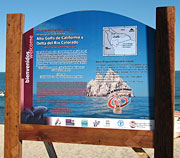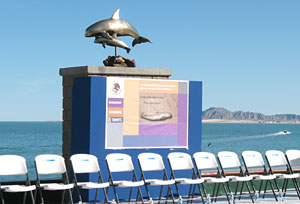 A
group of Mexicali and local officials joined the governor
of Baja on stage at the Malecon to pledge conservation
to the area's Biosphere Reserve. The Upper Gulf and
Delta Area of the Colorado River was designated a protected
reserve back in 1993, a time when the population of
the Vaquita Marina was estimated to be 500. The objective
of the reserve was the conservation of endangered species,
both from the Sea of Cortés and the Colorado
estuary, including the vaquita, the totoaba, the desert
pupfish, and the Yuma clapper rail. The 312,300 acre
territory is the exclusive home of the Vaquita Marina,
a specie endemic to the Upper Sea of Cortez.
A
group of Mexicali and local officials joined the governor
of Baja on stage at the Malecon to pledge conservation
to the area's Biosphere Reserve. The Upper Gulf and
Delta Area of the Colorado River was designated a protected
reserve back in 1993, a time when the population of
the Vaquita Marina was estimated to be 500. The objective
of the reserve was the conservation of endangered species,
both from the Sea of Cortés and the Colorado
estuary, including the vaquita, the totoaba, the desert
pupfish, and the Yuma clapper rail. The 312,300 acre
territory is the exclusive home of the Vaquita Marina,
a specie endemic to the Upper Sea of Cortez.
Mexico is the world' s 6th largest fish producer. Since
the early 1900s , three coastal fishing communities
have become established in the Upper Gulf : San Felipe
(in Baja California), El Golfo de Santa Clara and Puerto
Peñasco (in Sonora). In the past two decades
there have been dramatic changes in the targeted species.
As marine resource exploitation has grown the number
of species harvested has steadily increased (Cudney-Bueno
2000) . Today the waters of the Gulf of California supply
40%t of Mexico's total fisheries, and the Upper Gulf
itself provides 15% of the national fisheries. Small-scale
(" artisanal" ) fisheries in the Gulf contribute
more than 25% of the national fisheries production of
Mexico, and this is growing rapidly.
 Approximately
150,000 jobs are generated indirectly from small-scale
fishery activities (Conservation International 1998)
. Recent studies estimate that as many as 30,000 fishers
(industrial and small-scale) work in the Gulf of California
(Conservation International 1998). Although the flora
and fauna of the Upper Gulf is fairly well known the
biota of the Biosphere Reserve and Delta region are
largely unexplored. The coastline in the upper most
Gulf is not easily accessed, nor is the Delta itself,
and fundamental biological exploration remains to be
made in this region.
Approximately
150,000 jobs are generated indirectly from small-scale
fishery activities (Conservation International 1998)
. Recent studies estimate that as many as 30,000 fishers
(industrial and small-scale) work in the Gulf of California
(Conservation International 1998). Although the flora
and fauna of the Upper Gulf is fairly well known the
biota of the Biosphere Reserve and Delta region are
largely unexplored. The coastline in the upper most
Gulf is not easily accessed, nor is the Delta itself,
and fundamental biological exploration remains to be
made in this region.
In 2003, Hecor Lozano, as part of his field work for
his PhD thesis, talked to local fishermen in Puerto
Penasco. They had a number
of opinions and proposals for management and my interviews
confirmed not only the long fishery tradition (60% of
the fishers interviewed  had
20 or more years fishing in the area), but also the
economic crisis in the fisheries of the Upper Gulf.
Of the interviewees, 85 % thought that their fisheries
would be worse in the future, and almost 90% did not
want their sons to become fishers. Those with long fishing
experience recognized the negative impact of the fresh
water diversion from the Colorado River by consecutive
U.S. dams built since the1940s. Ninety per cent of the
fishers associated the dams with a negative effect on
their fisheries.
had
20 or more years fishing in the area), but also the
economic crisis in the fisheries of the Upper Gulf.
Of the interviewees, 85 % thought that their fisheries
would be worse in the future, and almost 90% did not
want their sons to become fishers. Those with long fishing
experience recognized the negative impact of the fresh
water diversion from the Colorado River by consecutive
U.S. dams built since the1940s. Ninety per cent of the
fishers associated the dams with a negative effect on
their fisheries.
The huge reduction of freshwater
and nutrients is the most likely cause for the dramatic
drop in population levels of the clam, Mulina coloradensis,
which, once extremely abundant, has nearly vanished
from the delta. Also, major changes have been documented
in the fisheries since the days of the 1940’s,
when the totoaba (Totoaba macdonaldi) and shark (Nasolamia
velox) reigned in the gulf. After severe depletion of
these stocks, fishers turned to shrimp (Lyptopenaeus
stylirostris) then to chano (a croaker: Micropogonias
megalops) and today the Gulf curvina (a scianid fish:
Cynoscion reticulates) and mollusks.
70% [of the fishers
Lozano talked with] believed that the Biosphere
Reserve is the best way to protect the marine resources
of the Upper Gulf.